Visiting a Chiang Mai elephant sanctuary is one of the most rewarding activities you can participate in during a visit to Northern Thailand. Elephants are Thailand’s official animal and seeing one up close and in-person is a truly magical experience.
Before heading to an elephant park, however, take a moment to learn more about it. How are its elephants treated?
There are lots of organizations in Chiang Mai that offer elephant encounters and not all of them are equal.
Some only let visitors observe elephants in their natural habitat from a distance. Others exploit the animals and keep them chained up most of the time. Still others fall somewhere in the middle of this spectrum and allow limited interaction between visitors and elephants.
Remember that just because a facility calls itself a sanctuary doesn’t mean that it actually is one. Some so-called sanctuaries allow tourists to ride on elephants or force the animals to perform tricks. These are red flags and you are better off avoiding these camps.
That being said, there is a lot of disagreement at the moment of what constitutes “ethical” treatment of elephants. It can be rather confusing to know what’s ok and which facility to add to your Chiang Mai itinerary.
I was a bit overwhelmed before my first visit to a Chiang Mai elephant sanctuary. So I spent hours researching the topic and educating myself about it. The following list of the best elephant sanctuaries in Chiang Mai is a result of that research.
Since I couldn’t visit all of them personally, I have enlisted the help of other travel bloggers to share their personal experiences at some of these facilities.
Table of Contents
A Brief History of Asian Elephants in Thailand
The official animal of Thailand, Asian elephants are also an endangered species. Due to extensive logging, much of the natural habitat needed to support elephants in the wild has been destroyed.
There are only 50,000 Asian elephants left on the entire planet. The number of elephants in Thailand plummeted to 3,456 captive elephants in 2007, along with approximately 1000 wild elephants.
Elephants have played a major role in Thailand’s history and performed manual labor for centuries. Asian elephants were widely used in the logging industry until Thailand banned logging in 1989. After that time, owners had to learn new ways to make money so they could keep their elephants fed.
At first, many elephants and their owners turned to begging. The elephants were often forced to perform tricks or beg for food. Other elephant camps turned to the tourism industry and offered elephant rides (also called elephant trekking) to tourists. These elephants were often kept in small pens or chained many hours of the day.
Unfortunately, the training required to tame elephants is often quite inhumane. Many captive elephants have undergone a process called elephant crushing, where they are placed in small cages and undergo corporal punishment until they submit to humans.
Thankfully, various organizations are helping elephant camps all over Thailand transition to more humane practices. Through outreach and education, they are partnering with trekking camps to help create business models based on ethical elephant tourism.
The Best Elephant Sanctuaries in Chiang Mai
The following list includes five excellent elephant sanctuaries in and around Chiang Mai.
There are a *lot* of elephant parks and sanctuaries in and around the city that didn’t make it onto this list. Just because an organization isn’t in this article doesn’t mean that it engages in unethical practices.
If you’re unsure, review the guidelines on choosing an ethical elephant sanctuary at the end of this article and do your own research before selecting one.
Elephant Nature Park
- Feeding Elephants – YES
- Touching Elephants – YES (limited)
- Bathing Elephants – NO
- Riding Elephants – NO
The largest and most well-known elephant sanctuary in Chiang Mai, Elephant Nature Park (ENP) provides homes for distressed elephants from all over Thailand.
Originally founded in 1998, the sanctuary covers approximately 250 acres and is located about 1.5 hours drive northwest of Chiang Mai. Many of the animals in the park are disabled or are recovering from injuries sustained from abusive practices in the logging or tourism industries.

This elephant stepped on a land mine and now receives treatment for the injury at Elephant Nature Park
Elephant Nature Park, along with its sister non-profit organization Save Elephant Foundation, is perhaps best-known for its leadership in the area of elephant conservation. Both organizations were founded by Sangduen “Lek” Chailert, a renowned conservationist and activist for the welfare of Asian elephants.
ENP not only provides a home for over 100 elephants on its property, it also works extensively with small family-run camps to help them transition to more ethical business models. The sanctuary also rescues dogs, cats, buffalo, and other animals as well.
Visits to Elephant Nature Park range in duration from a half-day trip (2,500 THB) to a 2-day sleepover (5,800 THB). The sanctuary also offers several volunteer vacations where you can work directly with the elephants for an entire week (starting from 12,000 THB).
Tickets to ENP often sell out weeks in advance, so be sure to book ahead. While this wasn’t the case during my visit due to the pandemic, it is still best to plan ahead. If you can’t secure tickets to the main sanctuary, consider booking a visit to a smaller camp that is managed in cooperation with Elephant Nature Park – such as Elephant Green Hill (below).
Elephant Green Hill
Recommended by Greta of Greta’s Travels
- Feeding Elephants – YES
- Touching Elephants – YES
- Bathing Elephants – YES
- Riding Elephants – NO
If you’re looking for the best elephant sanctuaries in Chiang Mai, you have to add Elephant Green Hill to your list. Elephant Green Hill is part of the “Saddle Off†project by Elephant Nature Park, but is located in a different sanctuary relative to the famous one.
The sanctuary is located in the Mae Tang Area, north of Chiang Mai - approximately a 1-hour drive from central Chiang Mai. It’s a very small sanctuary, with only three elephants, of which one baby elephant. Being a smaller location, the groups they host are also smaller.

An elephant gives herself a dust bath at Elephant Green Hill. Photo provided by Greta of Greta’s Travels.
They offer a full day experience for 2,500 THB, which includes pick-up and drop-off from Chiang Mai, a vegetarian buffet lunch, and a full day from 8AM to 4PM. The day starts with getting to know the elephants and preparing their food, which you will then give them alongside bananas.
After their meal you will go for a walk in the forest alongside the elephants. During the walk the elephants will most likely stop to eat more grass and plants along the way. The forest walk is followed by watching the elephants bathe, which you can also join in for if you wish to! Elephant Green Hill allows you to touch the elephants.
The bath is the last structured activity of the day, as you’re then given some free time to enjoy the buffet lunch while the elephants roam free. You can choose to watch them or walk near them after your meal.
Visiting Elephant Green Hill is one of the best ways to see elephants in Thailand. Being so close to them in a restricted group gives you the opportunity to get to know these beautiful animals, and since it’s part of Elephant Nature Park you know you can trust their ethical treatment of the elephants.
BEES – Burm & Emily’s Elephant Sanctuary
- Feeding Elephants – NO
- Touching Elephants – NO
- Bathing Elephants – NO
- Riding Elephants – NO
Burn & Emily’s Elephant Sanctuary (BEES) is widely regarded as one the most ethical elephant sanctuaries in the Chiang Mai area. At BEES, visitors observe elephants from a distance as it is a no-touch sanctuary. The goal is to provide a natural home for elephants to just be elephants with as little interaction with humans as possible.
BEES is located approximately 2.5 hours away from Chiang Mai near Doi Inthanon National Park. The sanctuary offers a variety of visitation programs that span from a single day to an entire week. During each of these visits, guests observe the elephants and also prepare their foods and help out with other tasks at the sanctuary.
It is my great regret that I wasn’t able to visit BEES during my visit to Chiang Mai. I had hoped to do so, but alas, it didn’t work out. Now it is on my bucket list for the next time I return to Northern Thailand.
Into the Wild Elephant Camp
- Feeding Elephants – YES
- Touching Elephants – YES
- Bathing Elephants – YES
- Riding Elephants – NO
Into the Wild Elephant Camp is a small organization that provides elephants with comfortable lives in a natural environment. Most of the elephants have retired from the logging or tourism industries and now spend their days roaming the jungle and playing in the mud.
Visits to the camp typically begin with an orientation by a member of the staff. The discussion covers various topics including the history of elephants in Thailand along with the camp’s philosophy on elephant care ethics. It’s a fascinating topic and the approach taken here is a bit different than, say, at a larger organization such as Elephant Nature Park.
After the orientation, guests spend some time getting to know the elephants by feeding them bananas from a raised platform. Then they follow the elephants into the forest on a short jungle trek. This is a great opportunity to watch the elephants graze on plants and shrubs as they wander freely among the trees.
Once back at the camp, visitors eat a home-cooked meal before changing into their swimwear. Then they accompany the elephants into a small pool where it’s time for one of the day’s highlights – bath time! Here, guests take turns swimming with the elephants and splashing water onto them.
Located in the Mae Wang District about 1.5 hours drive southwest of Chiang Mai, the park offers full-day tours (2400 TBH) or half-day tours (1700 TBH). The camp employs members of the local Karen hill tribe and supports efforts in giving back to the community by providing clothing and supplies to neighboring villages.
Chiang Mai Elephant Home
Recommended by Alexander from Travel Your Memories
- Feeding Elephants – YES
- Touching Elephants – YES
- Bathing Elephants – YES
- Riding Elephants – NO
One of the best Chiang Mai elephant shelters is Chiang Mai Elephant Home. Chiang Mai Elephant Home rescues and takes in elephants that come from abusive environments such as circuses. They focus on a better life for the elephants and provide a safe space for them to live and roam.
The nice thing about visiting Chiang Mai Elephant Home is that it is located between the mountains and jungle. Because they have a large piece of land, the elephants can roam here in a simulated natural environment.
The visit starts with an informational film with an explanation from the guide. You will learn all about the history of elephants in Thailand and what this animal means to Thai culture. Then you will meet the elephants and participate in feeding them.
After lunch the fun part starts. Visitors follow a group of elephants around the park and learn more about their behavior. During this time, you will have plenty of time to pet, feed, and admire them. This really makes it a unique experience. The best moment is washing the elephants which takes place at the end of the visit.
Before heading back to Chiang Mai, you will have the opportunity to shop for a souvenir such as a beautiful wooden elephant. The proceeds are used to buy food for the elephants at local markets.
Tours range from half day adventures (for 1700 THB) to spending 3 days in the jungle with the elephants (6500 THB). By Thai standards, a tour to a sanctuary is very expensive in comparison to other Thailand trip costs. It is worth every dollar, however, because all earnings are used for the welfare of the elephants.
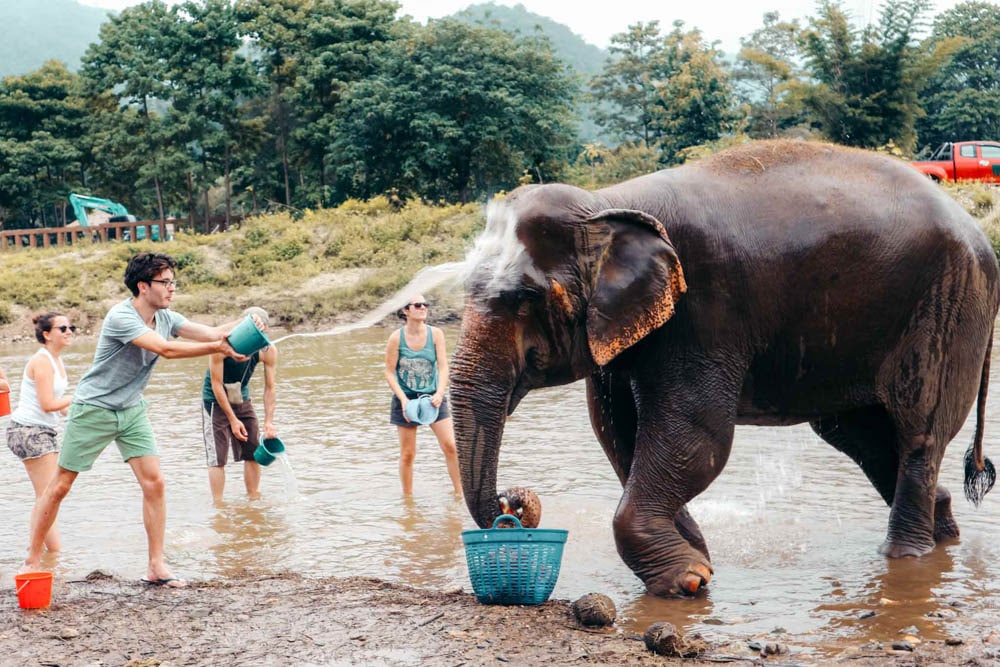
Bathing the elephants at Chiang Mai Elephant Home. Photo provided by Alexander from Travel Your Memories.
How to Choose an Ethical Chiang Mai Elephant Sanctuary
What exactly makes an elephant encounter “ethical”?
After depending on humans their entire lives, most rescued elephants cannot survive in the wild. So the goal of any Chiang Mai elephant sanctuary or park should be to enable the elephants to have as natural of a life as possible while in captivity.
This means providing elephants with plenty of room to roam around and to form natural relationships with eachother. They should have easy access to water for bathing and opportunities to exercise by walking in the jungle.
This can be more difficult than it sounds, especially for small family-run elephant camps that do not have many resources at their disposal. In some cases, the elephants have been part of the family for generations. Some of these small businesses have been hit particularly hard by the pandemic and cannot care for their elephants like they used to.
It is a complex issue and one that should be given thought and consideration before selecting a sanctuary to visit.
The word “sanctuary” is also under hot debate. Some conservationists believe it’s not possible to have a true sanctuary in Thailand any more due to deforestation. These conversations are ongoing and provide valuable insight into the treatment of these magnificent animals.
Here are a few things to consider as you make your selection.
Bullhooks and Chains
Bullhooks and sharp sticks have traditionally been used by mahouts to control elephants. They are used to punish and discipline elephants and ultimately force them into doing something they don’t want to do.
The use of these weapons has rightfully been discontinued or banned by most elephant sanctuaries.
Is it ever ok for a mahout to use a bullhook on an elephant? This is a question that is under debate by elephant conservationists. Most people argue that bullhooks should never be used under any circumstances. Others suggest that an extremely limited use in case of emergency (such as to save someone’s life or the elephant’s life) is ok.
The use of chains is similarly under debate by conservationists. They all agree that elephants should not be chained up as a rule, but should be allowed to wander freely and live as natural of a life as possible in a natural setting.
But is the use of chains ever ok? Some argue no, while others argue yes under limited circumstances – such as to transport an elephant to the hospital.
Riding Elephants
Providing elephant rides to tourists used to be a fairly common activity at elephant camps across Thailand. Now the practice is being phased out as it is widely considered to be an unethical practice.
If you find an elephant park that allows tourists to ride the elephants – avoid it. That is a big red flag.
Is it ok for mahouts to ride elephants? This question is still under debate by conservationists. Some organizations allow mahouts to occasionally ride on their elephants to help guide them or protect them. Others forbid this practice under any circumstances.
Touching or Bathing Elephants
What about touching or bathing elephants? When I researched this subject, I found less of a consensus in the literature.
Some conservation organizations vehemently oppose allowing tourists to touch elephants under any circumstances. Others allow it on a limited basis.
This is a subject that seems to be evolving over time. Elephant Nature Park and BEES used to allow tourists to bathe their elephants, but have discontinued the practice. Other elephant camps allow visitors to bathe the elephants under supervision of the mahouts.
It will be interesting to see how this issue changes over time and if other camps follow suit.


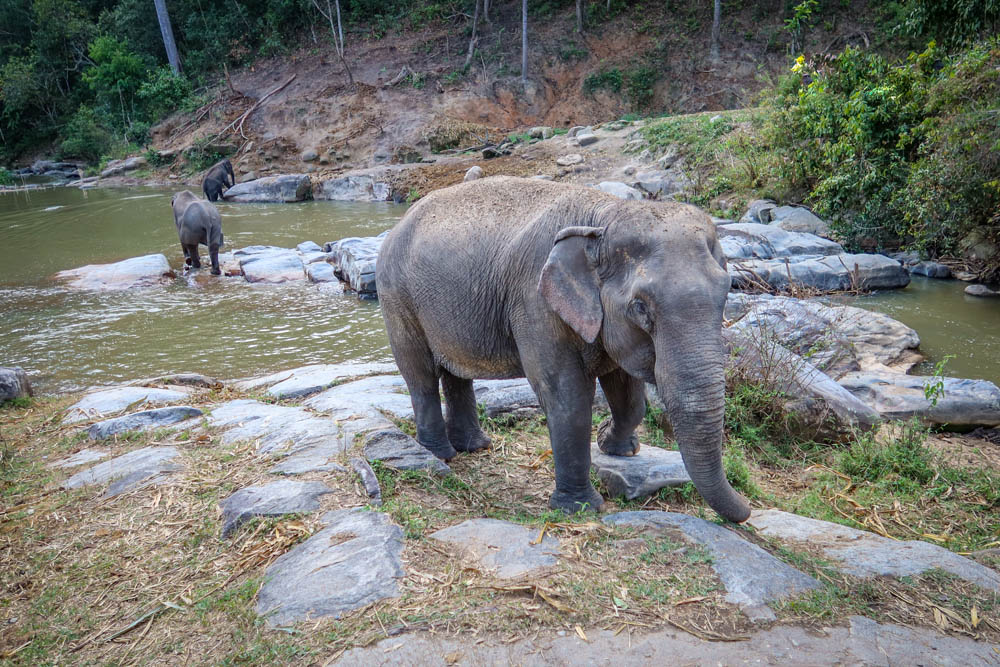



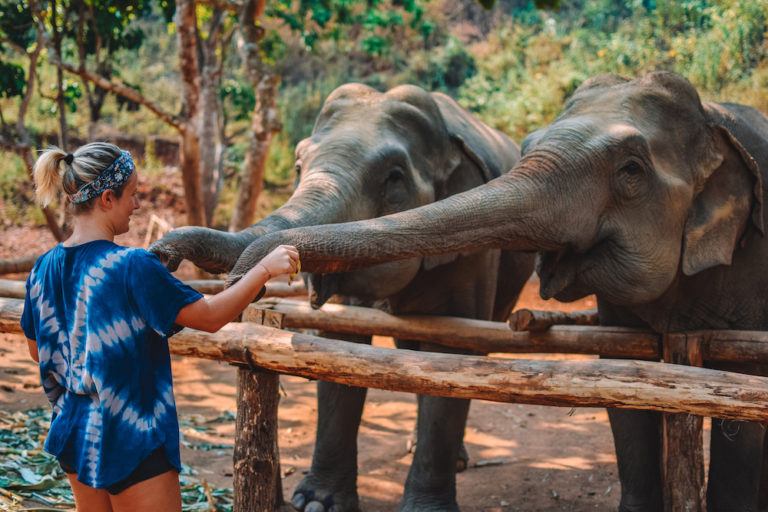


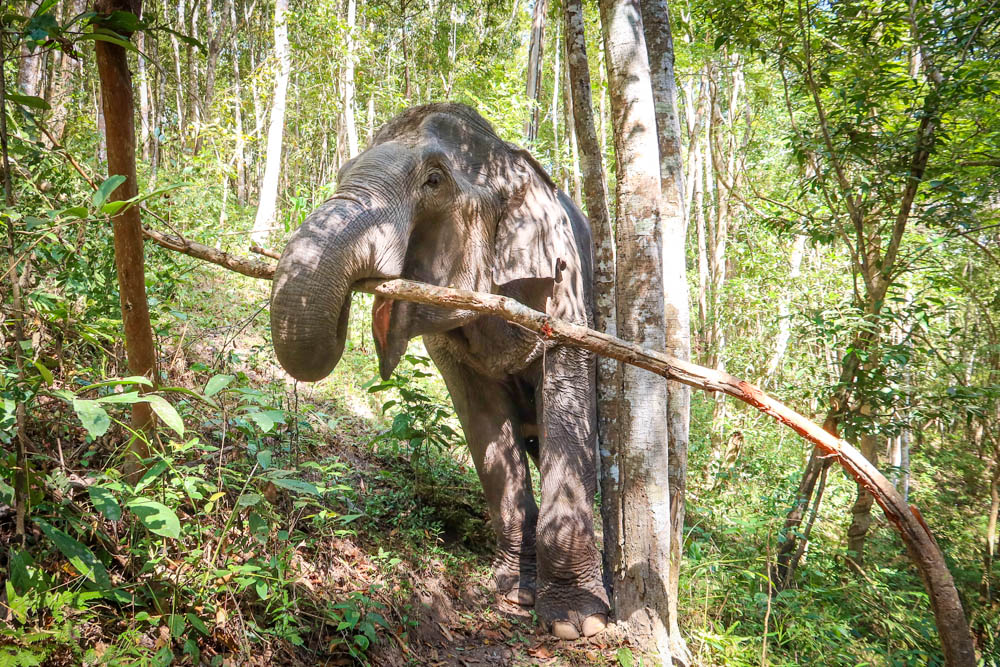




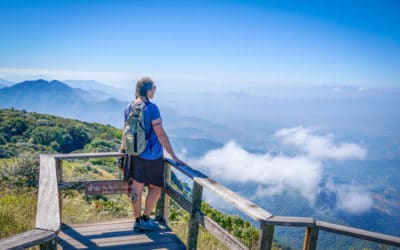
![9 Amazing Chiang Mai Markets, Walking Streets and Flea Markets [2022]](https://aramblingunicorn.com/wp-content/uploads/2022/12/Chiang-Mai-Gate-Market-Outside-400x250.jpg)

0 Comments